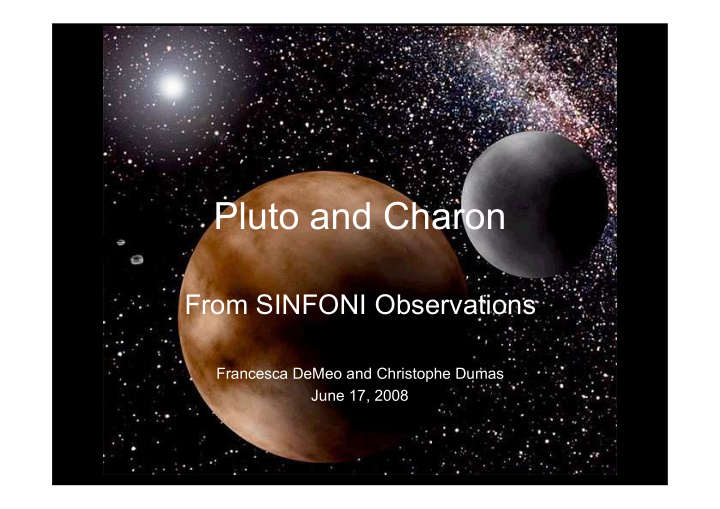



Pluto and Charon From SINFONI Observations Francesca DeMeo and Christophe Dumas June 17, 2008
My Project at ESO • PhD student at the Paris Observatory • DCDG student at ESO for 3 months to work with Christophe Dumas – Model Pluto and Charon spectra over different dates. – Extract spectra of hemispheres of Pluto from each data set.
The Data • VLT observations of Pluto and Charon with SINFONI instrument • Dates: May 13, June 9, and August 9, 2005 • Wavelengths: 1.4-2.4 µ m • Field of view: 0.8” x 0.8” • Exposure times: – 5 min for Pluto – 25 min for Charon
The Reduction: Bad Line Correction
Reduction • SINFONI Pipeline + bad pixel maps from IDL • IDL routines: – second sky subtraction – Alignment of object through cube by finding gaussian center and shifting flux maximum to a fixed center value. • Spectra extracted in qfitsview program – Spectra of hemispheres extracted using IDL routine.
Pluto in the Solar System
Pluto has 3 Moons
Definition of a Planet • A planet is a celestial body that: – is in orbit around the Sun – has a nearly round shape – has cleared the neighborhood around its orbit. • A dwarf planet is a celestial body that: – is in orbit around the Sun, – has a nearly round shape – has NOT cleared area around its orbit – is not a satellite. • All other objects except satellites shall be referred to as Small Solar System Bodies.
The Model • Radiative Transfer Model based on Hapke Theory • Creates intimate mixtures of input materials • Finds the “best fit” amounts of each input by minimizing X 2
Materials Modeled Charon Pluto • Crystalline H 2 0 ice • Methane • Amorphous H 2 0 ice • Nitrogen • Carbon • Titan Tholin • Titan Tholin
Charon NH 3 H 2 0 Crystalline H 2 0 H 2 0
Best Fits
Close Up NH 3 H 2 0 Pure NH 3 ??
Cryovolcanism • Cryovolcanoes are icy volcanoes. • Rather than molten rock, these volcanoes erupt volatiles such as water, ammonia, or methane. • Heat source comes from tidal heating or radioactive decay. • It is thought to exist on: Europa, Ganymede, Enceladus, Titan, Triton, Charon
Pluto CO CH 4 N 2 CO
Pluto Models
Increasing Grain Size (microns)
Separating Pluto’s Hemispheres N S
When will we know more? New Horizons Pluto fly-by in July 2015 • Primary objectives – Characterize the global geology and morphology of Pluto and Charon – Map chemical compositions of Pluto and Charon surfaces – Characterize the neutral (non-ionized) atmosphere of Pluto and its escape rate
Thank You
Recommend
More recommend